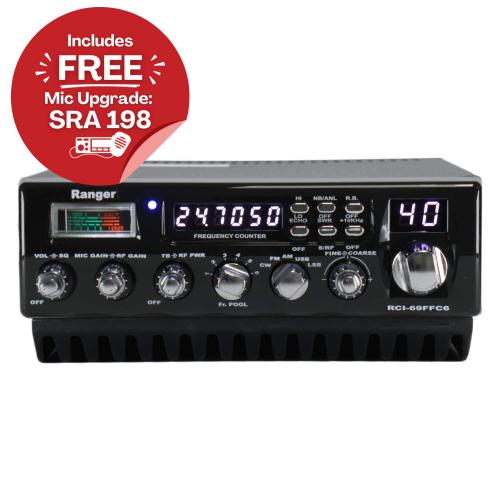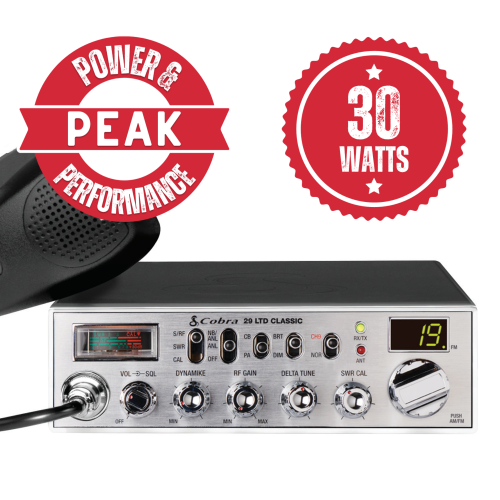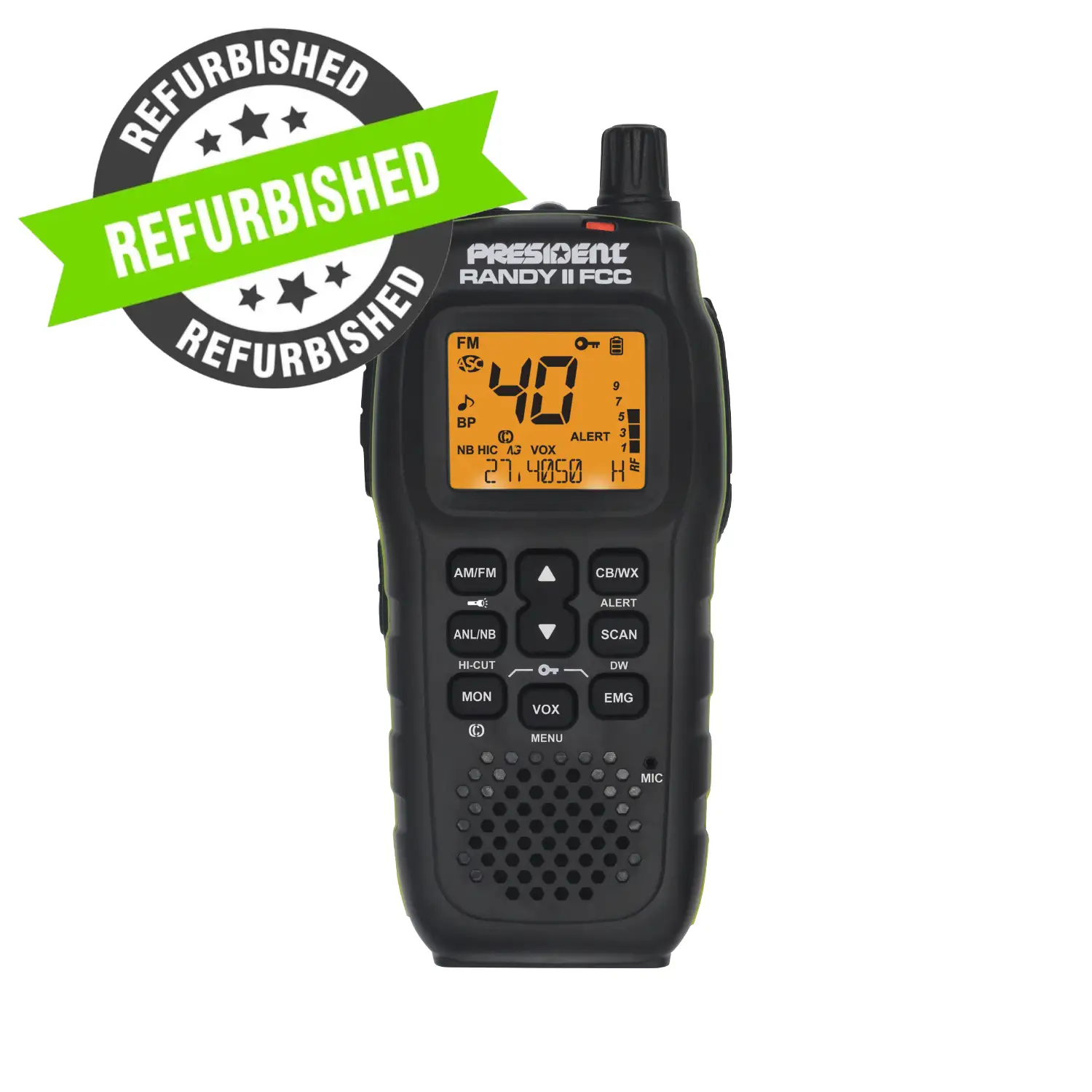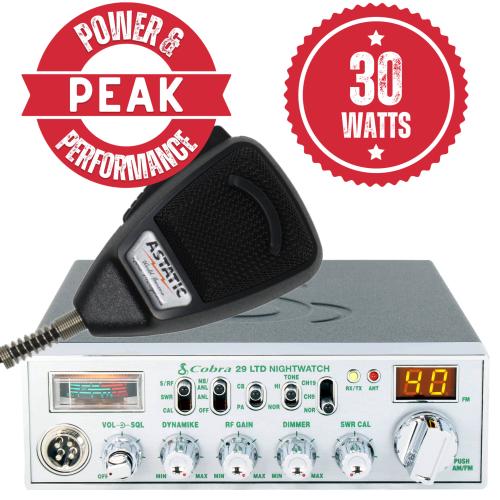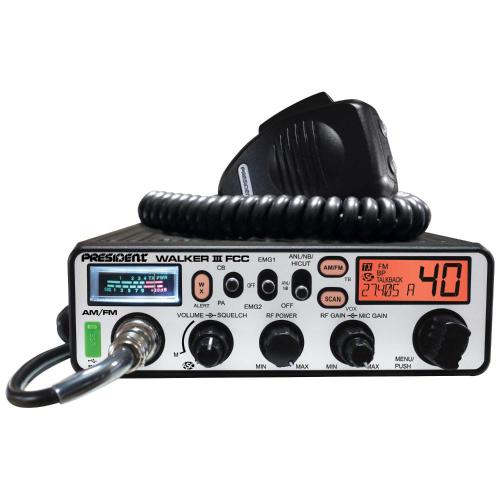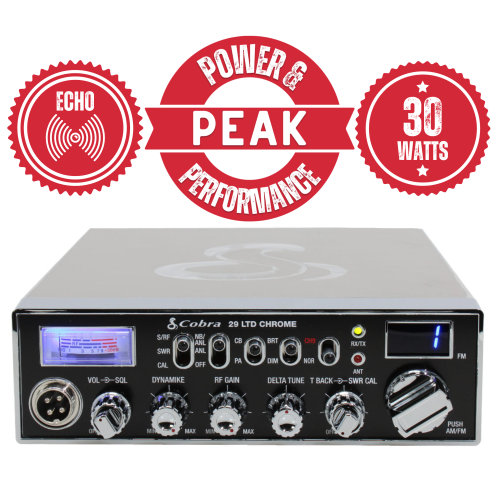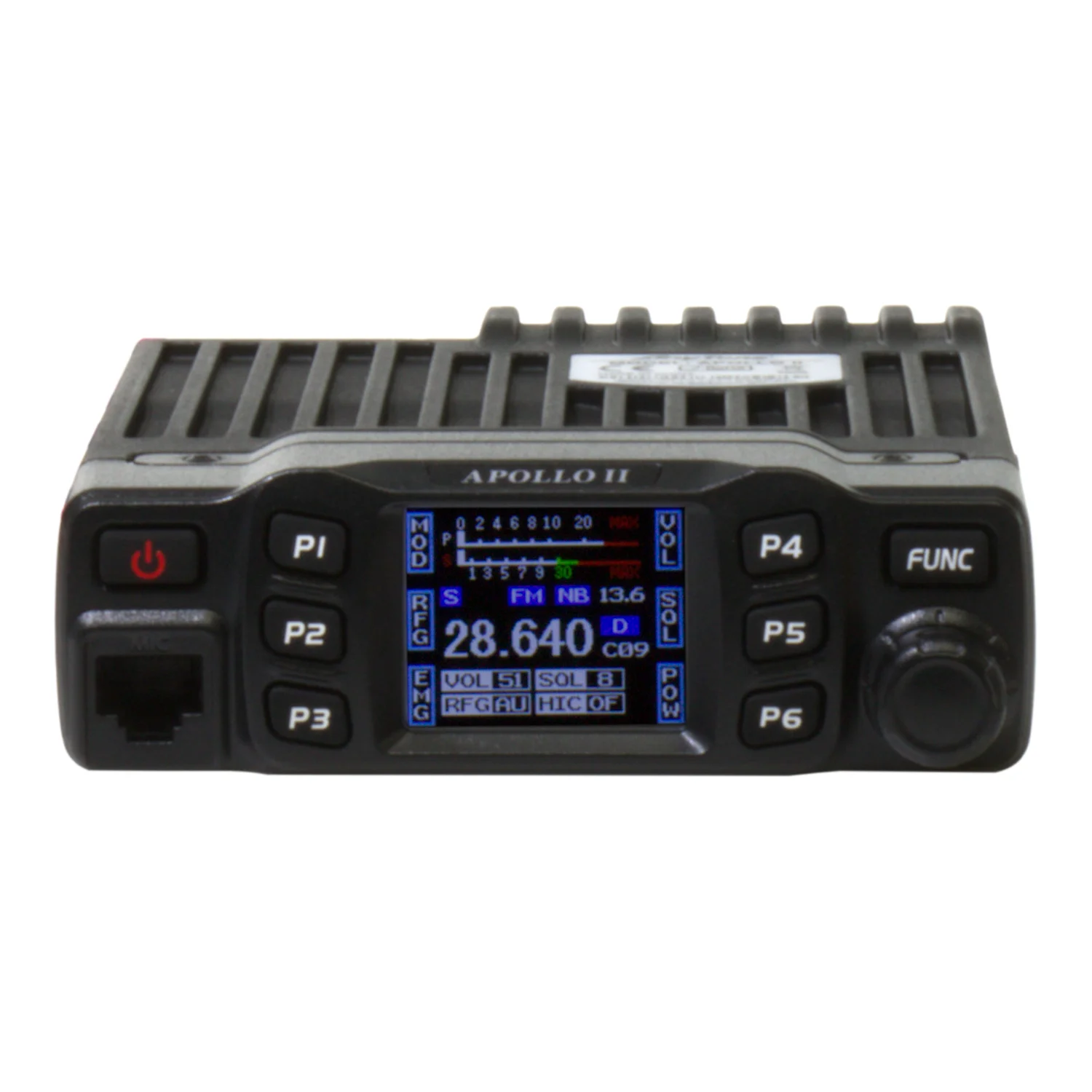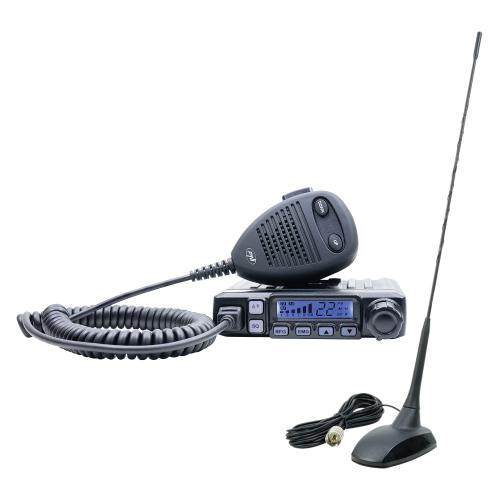FM CB radio and 10 meter radios
Frequency modulation, or FM, is a different method for encoding information in a radio wave. It offer much clearer audio. With the changes that the FCC enacted in 2021, CB radios can now have FM as a possible mode. AM is still the default mode for all CBs.
FM CB Radios Products
Filter results
Until very recently, all citizens band radios broadcast only on AM frequencies. Now, all that is changing. In September 2021, the Federal Communications Commission (FCC) approved the use of FM mode alongside AM mode and single-sideband (SSB) modes on citizens band (CB) radios. Truckers and amateur radio enthusiasts are touting this change as the biggest one to hit the industry in at least four decades.
What Is a CB Radio?
The fundamental nature of a CB radio allows a radio operator to transmit signals in two directions instead of simply receiving them, as is the case with regular radio service. CB radios are very popular among truck drivers and motor carriers, with millions of users taking advantage of this technology to communicate between vehicles.
How to Use an FM CB Radio
Until 2021, the only types of CB equipment manufactured for trucker and consumer use in the United States were AM-only and SSB radios. Adding FM mode to these types of older equipment won't be possible, but there are plenty of manufacturers already creating new two-way radios capable of receiving FM signals.
Differences Between AM, FM, and SSB Mode
The primary difference between SSB AM and FM radio is a matter of power output, or spectral
density. Modes change the way in which your voice is encoded in the radio wave. Each mode has pros and cons. SSB is the best for range, but the hardest to use. AM is the best for range at a slight cost of audio clarity. FM offers the best audio clarity, but will often have the worst range of the 3 modes. Think of your AM/FM stereo in your car. AM stations are typically used for talk-radio because clarity isn't as important as range. FM is where the music is because it sounds the best.
It's the same situation with AM and FM modes for CB.
FM radio is different from both double-sideband AM and SSB. It has a larger spectrum than the
usual AM radio, which means the power output is spread out over a wider bandwidth. As a
result, FM CB radios don't suffer from the same sound quality issues as traditional AM amateur
radios, even with the same watts output. Most truck drivers find that they have a better user
experience with the new FM radios since they create only minimal static and make it easier to
hear.
Now Is the Time to Invest in New Radio Equipment
As the FCC approves FM for CB, now is the time for truckers and amateur radio enthusiasts to
start upgrading equipment. The change to citizens band radio service means that anyone with a
handheld radio manufactured before September 2021 will be unable to transmit and receive FM
signals.
Note here that it will, however, still be possible to transmit on AM bands or SSB bands with the
right equipment. There are plenty of manufacturers with AM-only radios left in stock, so those
who don't want to substantially change how they use CB radios can also purchase leftover
goods at discount prices in 2022.
It's also worth noting that AM is still going to be the default mode for all CB's. FM and SSB are optional and will only be found on select models.
The Importance of Radio Location
As with everything in life, the switch to FM CB radios is not without its drawbacks. FM twoway
radios are fantastic at transmitting high-quality audio over short distances. They're great for line-
of-sight communications because the received power is sufficient and it's possible to sacrifice
some bandwidth to get better quality audio.
When the transmission needs to cover a greater distance, sacrificing bandwidth can become a
problem. The bandwidth is constrained, which means it won't always be possible to maintain
consistent radio service between two trucks with changing periodic locations. In this case, SSB
may be a better operating mode for personal radio services.
Volume Adjustment and Channels
Some proponents of making the change to FM bandwidths cite the ability to use their radios with less need for volume adjustment as a deciding factor. Instead of having to compete with multiple users and static from interference, users will be able to send and receive much clearer audio to others nearby who are using the same pre-determined channels. That said, long-haul drivers who prefer to listen to all of the radio chatter instead of focusing exclusively on maintaining communications with only nearby users on the same specific channel will probably prefer continuing to use AM channel 19.
Channel 19 has long been the one most frequently used by truckers despite the fact that there are many others open to use by everyone. Selecting a channel on FM radio will work differently as a result of the wider bandwidth options and truck drivers will need to pre-select frequencies before being able to begin two-way communications.
The addition of FM radio capabilities will not change the FCC's regulations regarding AM channel use. Truckers should still stick to channel 19 for east-west highway traffic and channel 10 or 21 for regional roads. HAM radio and amateur radio users are welcome to use any channel between 1 and 40, bearing in mind that channels outside of this frequency range are not for open use. The federal government, US military, and Civil Air Control are still assigned AM radio frequencies, as is the Business Radio Service. Ordinary users still cannot transmit via these frequencies.
How FM Got Added to Citizens Band Radio
There have been plenty of examples of FM bandwidth use in CB radio history, just not in the
United States or North America, more generally. Cobra has been fighting for the addition of FM
to CB radios for years, but it was only in August when the company was joined by President
Electronics that the FCC reconsidered its stance. It issued a memorandum opinion along with
an order of reconsideration last August and officially reversed its FM ban in September.
The eventual decision made by the FCC was influenced by its recognition that adding FM
capabilities to AM CB radios won't substantially change how they operate and will improve user experience. Amateur radio operators and truckers will still be able to use older equipment to
transmit via AM and SSB, and will only need to purchase FM-capable mobile radios if they are
interested in sending and receiving signals via this expanded bandwidth.
Frequently Asked Questions
Still wondering how the FCC's decision to allow FM transmissions on CB radios will impact everyday use? Here are a few answers to others' most frequently asked questions that could offer some clarity:
Model: Stryker SR447HPC2
- Compact Design: Fits easily into any vehicle for convenient installation.
- Multi-Color Faceplate: Customizable colors to suit your preference and style.
- Echo Function: Enhances audio clarity for better communication.
- Talkback Feature: Allows you to hear your own transmission for immediate feedback
- 75W High Performance: Ensures clear and reliable communication on the 10-meter band.
- Versatile Use: Ideal for amateur radio enthusiasts and professional drivers.
Model: President GEORGE FCC
- AM / FM / USB / LSB / WX / PA Modes
- CTCSS Tones & DCS
- Scan & Scan Skip
- Vox (Hands-free voice activation)
Model: Ranger RCI69FFC6
- FREE Includes Free Noise Canceling Mic Upgrade ($49.95 Value)
- 450+ WattsBird PeP Power Output (Dosy and RMS readings will be different)
- Modes: AM/FM/USB/LSB Modes
- Auto Dimmer: Light sensing module automatically adjusts faceplate lights
- Rear Cooling Fan: ensuring cool performance
Model: President RANDY II FM
- FM Mode
- Updated! Scan: new Skip/Scan feature
- Battery : Lithium-Ion
- Frequencies display
- Weather channel with Alert
- Dual watch
Model: Ranger RCI-29 BASE
- 80 Watts Mod
- AM / FM / LSB / USB Modes
- Echo & Talkback
- Dual Fans
Model: Cobra 29 Classic with FM
- NEW! FM Mode
- The industry standard in CB radios
- SWR meter
- Classic CB look and feel
- Standard 7.6in Wide
Model: President THOMAS FCC
- Works on either 12VDC or 24VDC power sources
- Extremely small size 4.9 IN wide and 1.8 IN tall
- Multi-color Faceplate
- Talkback
- Automatic Squelch
- 5V 2.1A USB-A Port
Model: AnyTone ARES II
- PC Programable (requires data cable): Free software allows you to customize nearly every function of the radio
- AM / FM / LSB / USB / WX modes
- NRC Noise Reduction Circuit: Greatly reduces background noises on receive, but also your transmission!
- New Update Frequency Counter: Hold down the top two buttons on the mic to see the frequency scroll across the channel display
Model: AT5555+
- NOTE - this is a different model from the Anytone AT5555N
- NEW! Includes CTCSS / DCS module
- All Mode: CW / AM / FM / USB / LSB
- Echo / Reverb & Talkback
- Hi-Cut Tone Control
- Extremely Stable on SSB
- 50 Watts PeP (Bird), 30 Watts RMS (Dosy)
Model: President BILL II FM
- The smallest FM CB available!
- Extremely small size
- Quick-release mounting bracket
- Weather channel with Alert
- 7 Color display
- Instant 9/19 Channel Selection
Model: Stryker SR955HPC+
- New Updated Model!
- 100+ Watts PEP
- AM / FM / SSB / WX / PA Modes
- Includes CTCSS / DCS Codes
- Shorter Case Design
- 6 Digit Frequency Counter
- Programmable
Model: President WASHINGTON
- AM / FM / USB / LSB Operating Modes
- Repeater Friendly
- Noise Reduction Circuit (NRC)
- Automatic Relay
Model: Cobra 29 Chrome with FM
- NEW! FM Mode
- All blue LED lights!
- Built-in SWR meter
- Stylish Chrome Case
Model: Cobra 29 Nightwatch
- AM/FM Modes
- Nightwatch Illuminated Faceplate
- Classic CB Radio Design
- Built-in SWR Meter
Model: Package Bundle 29FM-B1
- Peak Performance Upgrade
- FM Mode
- Fits into cubby holes or overheads
Model: SuperStar SS-676
- Slim Design - Easy to Mount in Small Spaces
- 80 Watts PeP Output
- AM / FM / PA Modes
- 7 Color Backlit Faceplate
Model: President Harrison FCC
- AM, FM, and Weather Modes
- CTCSS/DCS function
- Works on either 12VDC or 24VDC power sources
- Large LCD Multi-color faceplate
- Built-in SWR Meter
Model: COBRA 75 ALL ROAD
- Ultra Compact Design
- Wireless Bluetooth Connectivity
- Weather and Dust Proof - IP66 Rating
Model: President Richard
- Compact Case Size - Fits in most Cubbies
- 50 Watts PeP (Bird), 30 Watts RMS (Dosy)
- Built-in Echo and Talkback
- Selectable Multi-color display
Model: Walcott Radio RangerBasePack
- Complete Base Station Package
- Ranger RCI-29 10 Meter Radio with 80+ Watts
- Astatic Desktop Microphone
- Solarcon A99 Antenna & Tripod Kit
- 50 Foot Coax Cable
Model: PNI PNI-HP-6500
- Sleek - Low Profile Design
- AM and FM Modes!
- High performance
Model: AnyTone AT6666 PRO
- 80 Watts AM / SSB - 50 Watts FM
- CTCSS/DCS Code
- NRC Noise Reduction - Both RX & TX
- Adjustable Clarifier Control: Select between TX, RX, or both TX and RX
Model: Package Bundle WASHINGTON_BASE
- Complete Base Station Package
- AM / FM / SSB Modes
- 80+ Watts
- With A99 Base Antenna
Model: Package Bundle GEORGE-RANDY
- Mobile + Handheld CB Bundle
- FM Mode
- CTCSS Tones & DCS
- Vox (Hands-free voice activation)
Model: Package Bundle WALKER-DIGI
- Comprehensive CB radio starter kit including the President Walker III FCC.
- Peak Performance Upgrade for superior CB radio functionality.
- Includes Digimike Noise Canceling Microphone for clear communication.
- FM mode included for enhanced frequency modulation.
- Automatic Squelch Control to eliminate static and improve sound quality.
- Adjustable RF Power and Mic Gain for optimal performance.
- Weather mode to access NOAA weather stations.
- PA Ready for external communication via PA speaker.
- Color Changing backlighting with 7 selectable colors.
- USB Jack (2.1A) for charging devices.
- Standard DIN size for easy installation in any vehicle.
Model: Package Bundle 29FM-B3
- A complete radio system, just select your antenna!
- FM Mode for clearer signals
- Classic size fits in most semi truck cubby holes
Model: President JERRY FCC
- AM / FM modes
- Use as a handheld or in a vehicle
- NOAA Weather Scan & Alert
Model: President RONALD
- 50 Watts PeP (Bird), 28 Watts RMS (Dosy)
- Super compact design, less than 5" wide and only 1.77" tall
- Large, color selectable display for easy viewing
- Built in SWR meter
Model: President Twin-Randy-Package
- Pair of Randy Handhelds with FM Mode
- Tactical Antenna Folds In Half For Easy Storage
- Includes Clip-On Speaker Mics & Drop-in Chargers
- CTCSS / DCS
Model: AnyTone AT5555N-II-EXP
- Comes Updated and Expanded
- Weather Radio
- Mode: AM, FM, USB, LSB, PA
- PEP: AM 60W ; FM 50W; SSB 60W.
- New Noise Reduction feature that works on both RX / TX
- ECHO function
Model: Refurbished R-RANDY
- FM Mode
- Updated! Scan: new Skip/Scan feature
- Battery : Lithium-Ion
- Frequencies display
- Weather channel with Alert
- Dual watch
Model: Package Bundle 29NWFM-B1
- Peak Performance Upgrade
- FM Mode
- Illuminated Faceplate
- Classic Design
Model: Package Bundle 29NWFM-B2
- Peak Performance Upgrade
- Nightwatch Illuminated Faceplate
- Astatic 636L Noise Canceling Microphone
- Classic design & size
Model: Walker III
- *Updated* Now includes FM Mode
- Listen to live weather radio in your CB!
- Charge your phone from the front mounted 2.1A USB jack
- Small package, but big in performance
- DIN sized radio (6.75" wide x 2" tall)
Model: Package Bundle 29FM-B2
- Peak Performance Upgrade
- Echo & Talkback Installed
- FM Mode
- Fits into cubby holes or overheads
Model: Package Bundle 29CHRFM-B1
- Peak Performance Upgrade
- Chrome Case
- FM Mode
- Classic Size & Design
Model: Package Bundle 29CHRFM-B2
- Peak Performance Upgrade
- Echo & Talkback Installed
- Chrome Case
- FM Mode
- Classic Size & Design
Model: President WALKER-PEAK
- Comprehensive CB radio starter kit including the President Walker III FCC.
- Peak Performance Upgrade for superior CB radio functionality.
- Includes Digimike Noise Canceling Microphone for clear communication.
- FM mode included for enhanced frequency modulation.
- Automatic Squelch Control to eliminate static and improve sound quality.
- Adjustable RF Power and Mic Gain for optimal performance.
- Weather mode to access NOAA weather stations.
- PA Ready for external communication via PA speaker.
- Color Changing backlighting with 7 selectable colors.
- USB Jack (2.1A) for charging devices.
- Standard DIN size for easy installation in any vehicle.
Model: Package Bundle GEO-DIGI
- Peak Performance Upgrade
- President George CB with FM
- Digimike - Noise Canceling Microphone
- HP2 External Speaker
- CTCSS / DCS Codes
Model: Package Bundle JT-BILL
- Jeep Gladiator JT: 2019 - 2024
- Complete CB Radio System:
- President Bill CB w Cig Plug Power Cord
- 4' Black CB Antenna
- Stainless Hood / Fender Mount & Coax
Model: Cobra 25 FM
- Now with both AM & FM Modes
- Smaller Case Size than Full Sized CB's
- PA Speaker Compatible
Model: Roadking RKCBFM
- Classic Look & Size
- AM & FM Modes
- Fits into Overhead Cubby
Model: Refurbished R-RICHARD
- Refurbished
- Compact Case Size - Fits in most Cubbies
- 50 Watts PeP (Bird), 30 Watts RMS (Dosy)
- Built-in Echo and Talkback
- Selectable Multi-color display
Model: Apollo 2
- 40 Watts PeP (Bird), 28 Watts RMS (Dosy)
- Only 1.5 inches tall and less than 5 inches wide!
- Extermely Compact Chasis
- Full Color TFT Display
Model: SuperStar SS-158VDX
- All Mode: AM / FM / SSB / CW
- Auto Dim Display Lights
- Includes Ranger Noise Cancelling Mic ($59.95 Value)
- Six Digit Frequency Counter
- Built-in Echo & Variable Talkback
Model: Package Bundle JL-BILL
- Jeep Wrangler JL: 2018 - 2024
- Complete CB Radio System:
- President Bill CB w Cig Plug Power Cord
- 4' Black CB Antenna
- Attaches to Rear Door Hinge
Model: Walcott Radio R-29LTDCL
- Refurbished
- AM & FM Modes
- The industry standard in CB radios
- SWR meter
- Classic CB look and feel
- Standard 7.6in Wide
Model: Uniden BEARCAT880-FM
- AM & FM Modes
- Large Easy to Read Display
- Weather Band
- Memory & Scan Function
- Day / Night Brightness Modes
Model: Stryker SR94HPC
- Extermely Compact Chasis
- Full Color TFT Display
- 40 Watts PeP (Bird), 28 Watts RMS (Dosy)
Model: PNI 7120 EX48
- High performance, yet compact 18" magnetic antenna
- Matched with high performance and super compact CB
- Includes lighter plug
- Installation only takes minutes
Model: President TED FCC
- Compact Case
- Both AM & FM Modes
- 6 Pin Mic Configuration
- Channel Scan
- Accessory Volume Control
Model: PNI CRTS6900V
- All Mode: AM / FM / USB / LSB / CW
- CTCSS / DCS tones
- 50 Watts PeP (Bird), 30 Watts RMS (Dosy)
- PC Programmable
FAQ
A CB radio is usually AM. However, the FCC also recently approved the use of FM transmissions, which should be coming soon.
You can use FM on a CB radio only if it is equipped to send and receive FM transmissions. CB radios manufactured before September 2021 when the FCC approved FM transmission use are not FM-enabled.
The difference between AM and FM on CB radio is that AM tends to pick up interference and background noise, while FM focuses only on the strongest signal. As a result, you will only hear one voice in the cab at a time on the FM band, but it will be clearer.
Contact Us
- Walcott Radio
- 2940 N Plainview Rd Walcott
- Walcott, IA 52773
- Phone Support
- 1-844-925-2688
- M-F 10am to 5pm CST
- Store Hours
- M-F 9am-6pm
- Sat 9am-5pm
- Sun Closed


